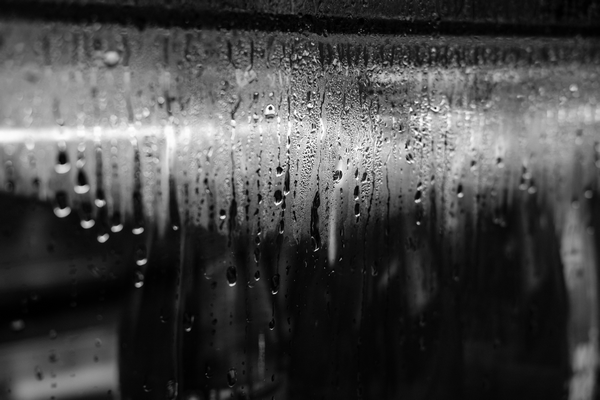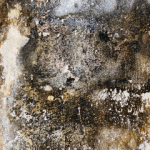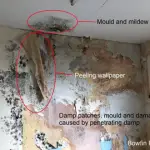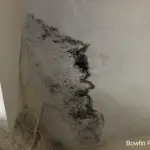
Do you have penetrating damp or a condensation problem?
You may have damp patches in your house but not sure what is causing it. Could it be penetrating damp or condensation? How you tell the difference between penetrating damp vs condensation is not always obvious to everyone.
So how can you tell the difference between penetrating damp and condensation? The easiest way to tell the difference between penetrating damp and condensation is to check if the signs of damp appear to be sitting on the surface of the wall vs having come through the wall. Penetrating damp tends to get worse during periods of rain vs condensation which is more prominent during the colder months.
In essence penetrating damp is cause by a problem on the outside of your house. Whereas condensation damp is caused by a problem on the inside of your house.
For you to understand the differences better it would help to know a bit more about how each type of damp happens in the first place. But also it will help to know what else to look for in order to help diagnose which type of damp you have.
What is penetrating damp in a house?
Penetrating damp is caused by moisture working its way laterally through the exterior of a property. So effectively the water works its way from the outside to the inside of the house.
Which is why you need to look to see if the damp has come through the wall rather than looking like it’s sitting on the surface.
If you find penetrating damp in a house this isn’t usually a problem. Unless it’s been left untreated for some time. It’s over time that the penetrating dampness can lead to other problems, like rotting timbers and in time potential structural problems too.
In addition to problems with the property itself, the mould caused from penetrating damp can result in health issues too. Health issues such as allergic reactions and a trigger for asthma attacks.
What can cause penetrating damp?
Penetrating damp, which is also referred to as structural damp, is often caused by leaking gutters or downpipes. Water can leak from a damaged gutter or downpipe and spill down the exterior of the property. Also, water can fall from a broken gutter onto the ground, and due to the height of the falling water, it can splash up onto the wall.
In both these cases where the exterior wall is constantly damp, the water or dampness works its way in through the fabric. Over time this can appear as a damp stain on interior plaster.
Penetrating damp can also be caused by a leaking roof due to damaged or missing tiles or slates.
How to fix penetrating damp
It’s very easy to fix penetrating damp by repairing the cause of the water leak on the exterior of your property.
This can be done by fixing the gutter or downpipes to stop any water leaks. Fix the roof to prevent any further water ingress or repair any damaged or cracked bricks or exterior plaster work.
What is condensation damp in a house?
Condensation damp is caused by warm moisture laden air condensing when it comes into contact with a cold surface. The term condensing is used to describe how water vapour turns to liquid water.
An example of what can cause water vapour is from a hot water shower or from the exhaust from a clothes dryer.
If you discover you have condensation damp in a house this isn’t usually a problem if it’s fixed right away. But the main problems with condensation damp is more related to health issues.
The mould formed as a result of condensation damp can be responsible for allergic reactions such as sneezing, runny noses and a skin rash. But it can also cause asthma attacks too.
What can cause condensation damp?
Condensation damp tends to happen in rooms where there’s a source of warm damp air. This includes bathrooms mostly as a result of steam from showers, but can also be from hot bathwater too.
Normally the only reason why condensation becomes a problem in a bathroom is because of bad ventilation. This can be because the extractor fan in the bathroom is either blocked, not working or is non-existent.
Condensation is also a problem in any room in a house where there’s a badly vented clothes dryer. If the warm moist air from a clothes dryer is not removed to the outside of a house, this will condense on the walls and windows to create damp and mould patches.
Kitchens are another place where condensation damp is found. Once again this is usually as a result of bad ventilation.
Another problem that will cause condensation damp is where wet clothes are hung up around the house to dry on radiators.
How do you fix condensation damp?
An easy fix for bathroom condensation is to fit a new extractor fan or repair the existing one. The same applies to kitchens. If you fix the ventilation by installing good extraction, your kitchen shouldn’t suffer from condensation damp.
To solve the problem of condensation caused from a clothes dryer, you simply need to pipe the exhaust outlet to the outside of the house. This can be done by cutting a hole in the wall to insert the dryer hose though.
Damp can lead to woodworm problems
A damp house can lead to a woodworm infestation, as the larvae of the woodworm beetle prefer damp wood. It’s important to fix your damp problem before any of the house timbers become saturated. But if the timbers have become wet from the damp, for example in your loft space, once these are dry again you won’t have a woodworm problem as they can’t survive in dry wood.
I hope you’ve got something from reading this article about should I buy a house that has damp
If you’ve got something from this article about “should I buy a house that has damp” please share it on your favourite social media site.
Also, if you have any questions, please feel free to comment below too. Alternatively, if you need more help, please feel free to contact us on our contact us page here. Or join the discussion and ask your question in the property forum.




